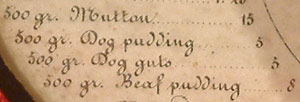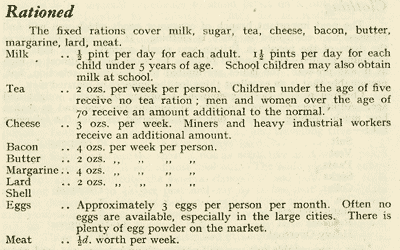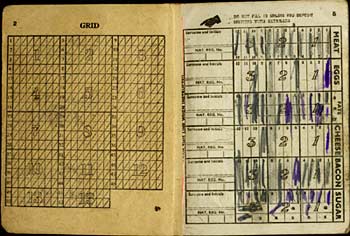Food rationing
It has always been a major problem in war to provide sufficient rations both for the fighting forces and civilians caught up in war. Women throughout history have played a key role in finding ways to keep their families from starvation during the disruption war causes to the production and distribution of foodstuffs.
Getting food onto the table in time of war can demand ingenuity and a lowering of expectations that seems unacceptable in times of plenty. Beloved pets and other forms of protein, such as rats, considered inedible under normal conditions, become essential when starvation threatens.
Siege of Paris bread, 1871 (MS 154)
A piece of bread from the siege of Paris with details of the rations available, including the note that dogs, cats and rats were also eaten (detail below)

During the Second World War in the United Kingdom, rationing was introduced to ensure a fair distribution of food, as it was known that the country's reliance on imported foods would threaten the supply of even the most basic commodities.
Many exotic foods, such as bananas, disappeared from the shops but even the supply of more ordinary products from the Channel Islands, such as onions, was cut off after the German occupation.

A list of food allowances (from a booklet called 'Back to Blighty')

Ration book from the Second World War (Acc 1938/1 and MS 425/17)
It was the Channel Islands, the only part of the British Isles to experience enemy occupation during the Second World War, which suffered severe food shortages. Even the Germans and the imported slave labourers were near starvation by the end of the war and this could lead to battles over food supplies resulting in fatalities as farmers and gardeners fought to protect their crops.
In war-torn Bosnia, women resorted to making this recipe for meatless meatballs due to the scarcity and expense of meat:
- 6 tablespoons yeast
- 6 tablespoons breadcrumbs
- Salt
- First mix the yeast and breadcrumbs then add water to pack together. Form balls with spoon then fry in oil.
The women of Rwanda typically prepare this recipe for porridge to feed children during times of food scarcity. This recipe makes enough to feed one child for one day.
- 12 grams of Sosoma (sorghum, soya and maize flour mixed in equal proportions)
- 8 cups of boiling water
- 1 cup of cold water
- 12 teaspoons of sugar or a small amount of salt
- Mix Sosoma with 1 cup cold water. Add this mixture to the boiling water and stir gently for 5 to 10 minutes. Allow to cool for several minutes and then add sugar or salt if it is available.
Project Independence information
Next: Women survivors of recent conflicts